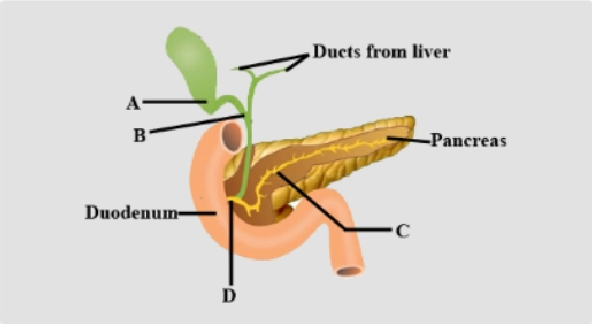
The given diagram shows a duct system of liver, gallbladder and pancreas. Write the names of ducts from A to D

A - Cystic duct, B - Common bile duct, C - Pancreatic duct, D – Hepato-pancreatic duct
A - Common bile duct, B - Cystic duct, C - Pancreatic duct, D – Hepato-pancreatic duct
A - Cystic duct, B - Bile duct, C - Hepato-pancreatic duct, D – Pancreatic duct
A - Cystic duct, B - Pancreatic duct, C - Common bile duct, D – Hepato-pancreatic duct

Answer
468k+ views
Hint:- A duct is a tube-like structure found in various body parts which helps in transferring the secretions. The pancreas and liver produce pancreatic juice and bile respectively which helps in the process of digestion. After the production of pancreatic juice and bile, they have transferred to Duodenum.
Complete step-by-step solution:-
The cystic duct contains “Spiral valves of Heister” which do not provide much resistance to the flow of bile and it connects the gallbladder with the common hepatic duct.
The cystic duct (which comes from the gallbladder) and the common hepatic duct combine together and it will form the common bile duct. Later the common bile duct will connect with the pancreatic duct and this will form the ampulla of Vater.
The pancreatic duct is part of a system of ducts in the pancreas. Pancreatic juice is released into these ducts.
The hepato-pancreatic duct opens into the duodenum. These ducts carry both bile juice and pancreatic juice. This duct is a union of the common bile duct and pancreatic duct.
Here A is a Cystic duct that is coming out from the gallbladder, ‘B’ is a Common bile duct, ‘C’ is a Pancreatic duct and ‘D’ is a Hepato-pancreatic duct.
So the correct answer is option (A).
Note:-
Cystic duct, common bile duct, pancreatic duct, and Hepato-pancreatic duct are found in the gastrointestinal tract. This track starts from the mouth and ends at the anus which includes all the organs of the digestive system. Various kinds of smooth muscle sphincters which help in the regulation of the flow of bile and pancreatic juice through the ampulla of Vater.
Complete step-by-step solution:-
The cystic duct contains “Spiral valves of Heister” which do not provide much resistance to the flow of bile and it connects the gallbladder with the common hepatic duct.
The cystic duct (which comes from the gallbladder) and the common hepatic duct combine together and it will form the common bile duct. Later the common bile duct will connect with the pancreatic duct and this will form the ampulla of Vater.
The pancreatic duct is part of a system of ducts in the pancreas. Pancreatic juice is released into these ducts.
The hepato-pancreatic duct opens into the duodenum. These ducts carry both bile juice and pancreatic juice. This duct is a union of the common bile duct and pancreatic duct.
Here A is a Cystic duct that is coming out from the gallbladder, ‘B’ is a Common bile duct, ‘C’ is a Pancreatic duct and ‘D’ is a Hepato-pancreatic duct.
So the correct answer is option (A).
Note:-
Cystic duct, common bile duct, pancreatic duct, and Hepato-pancreatic duct are found in the gastrointestinal tract. This track starts from the mouth and ends at the anus which includes all the organs of the digestive system. Various kinds of smooth muscle sphincters which help in the regulation of the flow of bile and pancreatic juice through the ampulla of Vater.
Recently Updated Pages
Using the following information to help you answer class 12 chemistry CBSE

Basicity of sulphurous acid and sulphuric acid are

Master Class 12 Economics: Engaging Questions & Answers for Success

Master Class 12 Maths: Engaging Questions & Answers for Success

Master Class 12 Biology: Engaging Questions & Answers for Success

Master Class 12 Physics: Engaging Questions & Answers for Success

Trending doubts
What is the Full Form of PVC, PET, HDPE, LDPE, PP and PS ?

Figure shows a conducting loop ABCDA placed in a uniform class 12 physics CBSE

Explain with a neat labelled diagram the TS of mammalian class 12 biology CBSE

The first general election of Lok Sabha was held in class 12 social science CBSE

How do you convert from joules to electron volts class 12 physics CBSE

The term ecosystem was coined by a EP Odum b AG Tansley class 12 biology CBSE




